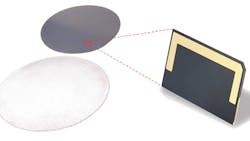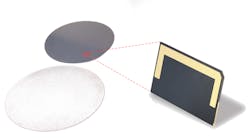This file type includes high resolution graphics and schematics when applicable.
Diamond is known to be an extremely hard material that’s excellent for cutting tools. Less well known is the fact that it’s also an excellent thermal conductor—up to five times better than copper and 10 times better than other commonly used ceramic heat spreaders. In addition, it has mechanical and electrical properties that make it a strong candidate for heat spreaders for high-power, high-density circuits and devices, such as gallium-nitride (GaN) discrete transistors, monolithic-microwave integrated circuits (MMICs), and laser diodes.
Element Six has developed a process using chemical vapor deposition (CVD) by which thin diamond films can be synthesized under tightly controlled conditions (see photo). This results in CVD polycrystalline diamond with high consistency and repeatability, ideal for heat spreaders with the extremely low thermal resistance and isotropic behavior needed to “get the heat out.”
Diamond is a low-density material with high mechanical strength that has a low dielectric constant and is intrinsically a good electrical insulator. It is unparalleled as a thermal conductor, with the low thermal resistance and isotropic behavior that enables heat to flow freely through the material in all directions.
Element Six has engineered the material in many forms, in thicknesses from 100 to 2,000 µm and wafer diameters to 140 mm for mechanical and electrical products. In addition to its CVD growth process, the firm developed laser-cutting and polishing methods for achieving low surface roughness that have the high flatness required to achieve gap-free interfaces with semiconductor substrates and other packaging materials.
For heat-spreader applications, the company offers its Diafilm TM line of materials, which includes materials with four grades of thermal conductivity: Diafilm TM100, TM150, TM180, and TM200. As a heat spreader for high-power packages, all four grades offer considerably higher thermal conductivity than commonly used high-power package materials, including copper (Cu), beryllium oxide (BeO), and aluminum nitride (AlN).
All four grades of heat-spreader CVD synthetic diamond materials have a Young’s modulus between 1,000 to 1,100 GPa and density of 3.52 × 103 kg/m3. The specific heat capacity for all four grades is 520 J/kg/K at 300 K. Diafilm TM100 materials have thermal conductivity of better than 1,000 W/m-K at 300 K and better than 900 W/m-K at 425 K. They exhibit a coefficient of thermal expansion (CTE) of 1.0 ± 0.1 ppm/K at 300 K and 4.4 ± 0.1 ppm/K at 1000 K. Thermal diffusivity is greater than 5.5 cm2/s at 300 K.
The Diafilm TM150 synthetic diamond head-spreader materials offer higher thermal conductivity, with measured values of better than 1,500 W/m-K at 300 K and better than 1,400 W/m-K at 425 K. The CTE of this material is 1.0 ± 0.1 ppm/K at 300 K and 4.4 ± 0.1 ppm/K at 1000 K. Thermal diffusivity is greater than 8.3 cm2/s at 300 K.
Going even higher, Diafilm TM180 materials have thermal conductivity of better than 1,800 W/m-K at 300 K and better than 1,500 W/m-K at 425 K, with CTE of 1.0 ± 0.1 ppm/K at 300 K and 4.4 ± 0.1 ppm/K at 1,000 K. Thermal diffusivity of this material is greater than 10.0 cm2/s at 300 K. For the highest thermal conductivity, Diafilm TM200 diamond materials maintain thermal conductivity of better than 2,000 W/m-K at 300 K and better than 1,500 W/m-K at 425 K. They exhibit a CTE of 1.0 ± 0.1 ppm/K at 300 K and 4.4 ± 0.1 ppm/K at 1,000 K, with thermal diffusivity of greater than 11.1 cm2/s at 300 K.
These are not considered “drop-in” components to be added to different semiconductor packages for a quick improvement in thermal efficiency. Still, Element Six works closely with customers in terms of thickness, metallization, and even soldering requirements to ensure that a heat-spreader solution based on CVD synthetic polycrystalline diamond achieves optimum results, enabling higher power levels in smaller size packages and circuits.
All materials are manufactured to ISO 9001:2000 quality standards and are literally designed “to last a lifetime.” And, in the cases of higher-power semiconductor devices (such as lasers, GaN transistors, and MMICs), they help ensure that operating lifetime is as long as possible.
Editor’s Note: More details on the CVD synthetic diamond materials from Element Six will appear in a future contributed technical article on www.mwrf.com.
Element Six Technologies, a De Beers Group Co., 3901 Burton Dr., Santa Clara, CA 95054; (408) 986-2400
This file type includes high resolution graphics and schematics when applicable.
About the Author
Jack Browne
Technical Contributor
Jack Browne, Technical Contributor, has worked in technical publishing for over 30 years. He managed the content and production of three technical journals while at the American Institute of Physics, including Medical Physics and the Journal of Vacuum Science & Technology. He has been a Publisher and Editor for Penton Media, started the firm’s Wireless Symposium & Exhibition trade show in 1993, and currently serves as Technical Contributor for that company's Microwaves & RF magazine. Browne, who holds a BS in Mathematics from City College of New York and BA degrees in English and Philosophy from Fordham University, is a member of the IEEE.


